Dental Implants – What are they?
A) What is an implant?
Dental implants are mechanical devices that have been designed to substitute for individual missing teeth. They function as an artificial tooth root, on top of which some type of dental prosthesis (a dental crown, bridge or denture) can then be placed.
“Endosseous root-form” tooth implants.
The most common kind of implant placed by dentists is the “endosseous root-form” type.
Implants are used to replace individual teeth.
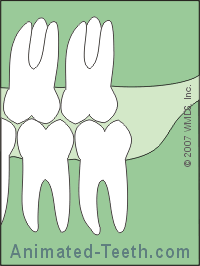
A dental implant used to replace a molar.
- The term “endosseous” refers to the fact that the implant is embedded within bone tissue.
- The term “root-form” refers to the fact that the shape of the implant is somewhat similar to the shape of a natural tooth’s root. (This isn’t precisely accurate in the sense that some teeth have multiple roots. – See animation.)
“Osseointegrated” implants.
The term “osseointegrated” (or “osteointegrated”) refers to the fact that there is a direct connection (fusion) between the surface of the implant and living bone tissue. Virtually all endosseous root-form implants are the osseointegrated type.
B) The component parts of an implant.
Components of a dental implant.
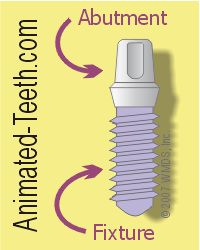
The fixture and abutment parts of an implant.
#1) The implant “fixture.”
a) Fixture construction.
Materials.
The material used to fabricate an implant fixture can either be a metal or a ceramic.
- Titanium – “Commercially pure” (over 99.5% pure) titanium or one of its alloys (titanium combined with aluminum and vanadium, so to improve strength and fracture resistance) may be used.
- Zirconia – This is a high-strength ceramic that’s used in a number of dental applications (including making dental crowns).
Shape.
A fixture can either have a hollow or solid body, with a cylindrical or screw-shaped design.
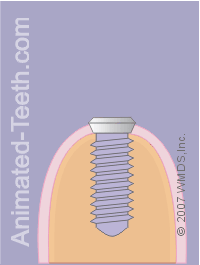
The component parts of an implant: a) Implant fixture. b) Abutment. c) Crown.
b) Special surface treatments.
c) Special fixture coatings.
The surface of a fixture is sometimes coated with a special bone-regeneration material such as hydroxyapatite. Some manufacturers feel that this helps the osseointegration (fusion) process to take place more rapidly. (The need for this is also debated.)
#2) The implant abutment.
The abutment portion of a tooth implant is that part that lies at and above the gum line. It’s the part that supports and secures the dental work (crown, bridge, denture) that’s placed on it.
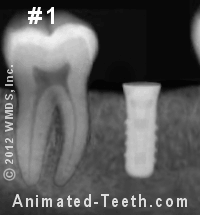
Components: 1) Implant fixture. 2) Abutment. 3) Crown.
- The abutment is typically not added to the implant fixture (screwed or cemented on) until after the osseointegration process (implant-to-bone fusion) has taken place.
However, in cases where esthetics are a concern, it may be possible for the dentist to place the implant fixture, abutment and provisional restoration (i.e. temporary crown) all at the same appointment.
- The abutment may have a metal, ceramic or hybrid construction. In some cases (especially with ceramic implants), the fixture and abutment may be fabricated as a single integrated unit.
(In our animation above, Image #2 shows an x-ray of an implant fixture with its abutment in place.)
#3) The dental prosthesis.
The term “dental prosthesis” refers to the dental work (crown, bridge, denture) that the implant supports.
Depending upon its design, it may be cemented or screwed (i.e. crowns, bridgework), or else clipped or snapped (i.e. dentures), into place.
(In our animation above, Image #3 shows an x-ray of an implant that supports a dental crown.)
Implant contraindications – Who makes a good candidate for a dental implant?
Once a decision has been made that an implant will be considered as a treatment option, the dentist must make a determination about the patient’s suitability for it.
Factors that must be evaluated include:
- The patient’s health (medical conditions, medicines, age).
- Patient habits (smoking, tooth grinding, poor oral hygiene).
- Jawbone quantity and quality at the placement site.
1) Medical considerations.
a) Medical conditions that contraindicate the placement of dental implants.
There are a number of conditions that typically bar elective oral surgery, and therefore preclude the placement of dental implants. Some of them include:
- Recent myocardial infarction (heart attack) or cerebrovascular accident (stroke). | Valvular prosthesis (artificial heart valve) surgery. | Immunosuppression (a reduction in the efficacy of the immune system). | Bleeding/Clotting problems. | Active treatment of malignancy (cancer). | Drug abuse. | Psychiatric (mental) illness.
Other considerations.
Clearly, any condition that places the patient at risk for further health deterioration must be resolved before an elective dental procedure such as this one is considered.
b) Medical conditions that may interfere with an implant’s success.
Any condition that impairs the normal healing process can interfere with the successful placement of a dental implant.
As an example, uncontrolled diabetes mellitus delays the process of wound healing, and therefore people who have this condition do not make good candidates.
However, the mere presence of a disease does not necessarily preclude placement, or significantly alter the implant’s long-term outlook, if the medical condition is controlled by treatment or medication.
c) Medicines.
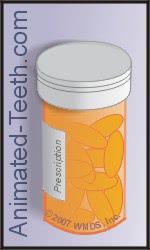
Make sure your dentist has a complete list of all of your medications.
Drugs of concern.
High on a dentist’s list of concerns will be those drugs that are utilized in the treatment of cancer, those that inhibit blood clotting and also bisphosphonates (a class of drugs used in the treatment of osteoporosis).
d) Age considerations.
Young adults.
As a general rule, placing tooth implants should be delayed until the age of 18 to 19 years. This age generally correlates with that time frame when an adolescent’s jaw growth and development can be considered to be complete.
Advanced age.
Advanced age doesn’t necessarily contraindicate the placement of dental implants but it can present challenges.
A failure to practice effective oral hygiene, a phenomenon that often accompanies advanced age, places the long-term survival of an implant at risk.
However, in the case where an elderly patient has trouble wearing or cannot tolerate a removable appliance (partial or full denture), dental implants may be a reasonable option and one that makes it possible for them to maintain adequate nutrition where otherwise they could not.
2) Patient habits that may conflict with implant placement.
a) Smokers may have lower long-term implant success rates than nonsmokers.
Many (but not all) studies have reported that the long-term success rate of tooth implants of smokers is lower than for those who don’t.

A habit of smoking may compromise the long-term success of dental implants.
This does not mean that smoking should be considered to be an absolute contraindication for placement. But smokers need to realize that if they continue their habit they’re likely at higher risk for implant failure.
If you do smoke.
Some suggested treatment protocols call for smoking cessation one week prior to, and then eight weeks following, the placement procedure. Thus helping to minimize the effect it may have on the early stages of the implant healing process (osseointegration).
b) Bruxism (tooth clenching and grinding) may compromise dental implant success.
Bruxism is a term that refers to the habit of clenching and grinding one’s teeth.
The act of bruxing can result in excessive forces being directed to the bone-implant interface. And this type of biomechanical overload has been correlated with tooth implant failure.
However, a habit of bruxing should not necessarily be considered to be a contraindication for placement. But if a patient is not willing to address this issue, either by controlling their habit on their own or wearing a mouthguard appliance that can help to lessen its effects, an implant may make a poor choice.
c) Poor oral home care.
Some research studies have reported a correlation between ineffective brushing and flossing and dental implant failure. This association, however, has yet to be definitively established.
Peri-implantitis.
It is established that if bacteria are allowed to colonize in the gum tissue surrounding an implant, their presence can lead to an inflammatory response called peri-implantitis. If this condition is left untreated, it can lead to a loss of supporting bone, a loss of osseointegration (bone-to-implant fusion) and ultimately implant failure.
Are antibiotics needed before a patient’s implant procedure?
Possibly taking them is indicated. Bacteria introduced into an implant’s surgical site during its placement procedure may lead to the development of infection, and ultimately the implant’s failure. It’s estimated that 6% of implants placed without the patient receiving antibiotics fail. (Esposito 2010)
Considerations about antibiotic use.
The decision to have a patient take antibiotics as a preventive for post-implant placement infection must be made by the dentist.
- When they feel doing so is indicated, taking the initial (possibly only) dose as little as 1 hour prior to the patient’s procedure has been shown to be effective.
There is no evidence that initiating the antibiotic regimen postoperatively is beneficial.
- Studies suggest that taking antibiotics will prevent 1 implant failure for every 25 cases treated this way.
However, in light of the possible complications and adverse effects associated with taking antibiotics (like experiencing an allergic reaction), with healthy patients the need/justification for taking this step is debated.
▲ Section references – Esposito
Page references sources:
Esposito Interventions missing teeth: antibiotics at dental implant placement to prevent complications.
All reference sources for topic Dental Implants.
